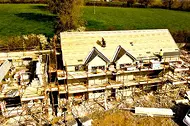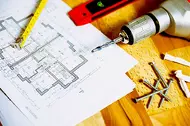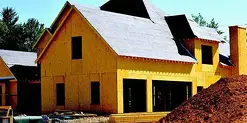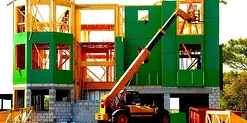Secrets to Budgeting Your Home Build Without Breaking the Bank
 By
Trent Bradley
·
10 minute read
By
Trent Bradley
·
10 minute read

Building your dream home in New Zealand doesn't have to drain your life savings or force you into financial stress. With careful planning, smart decision-making, and strategic cost management, you can successfully budget home build NZ projects that deliver exceptional value without compromising on quality or your long-term financial security.
Table of Contents:
- The Foundation of Smart Building Budgets
- Strategic Land Selection for Budget Builds
- Design Strategies That Maximize Value
- Material Selection Strategies
- Smart Construction Strategies
- Financing Strategies for Budget Builds
- DIY and Sweat Equity Opportunities
- Cost Control During Construction
- Long-term Value Considerations
- Regional Money-Saving Opportunities
- Technology and Modern Efficiency
- Creating Your Budget Strategy
- Related Reading: Construction Financing Guide
- Frequently Asked Questions
Key Takeaways
- Complete building budgets include 20-30% beyond construction contracts for consents, services, landscaping, and contingencies—not just the build price
- Apply 80/20 rule: invest 80% in structural integrity, weatherproofing, and core systems that can't be upgraded; 20% in finishes that improve over time
- Rectangular floor plans and simple roof lines cost 15-25% less than complex designs while two-storey builds maximize space on smaller sections
- Level sections with existing services save $20,000-$80,000 in earthworks and infrastructure versus sloping sites requiring extensive preparation
- Quality insulation and efficient heating systems cost $5,000-$15,000 more upfront but save $1,500-$3,000 annually in energy costs over decades
- Construction variations are the biggest budget killer—require written quotes and evaluate each against total budget before approval
The key to affordable home building lies not in choosing the cheapest options, but in understanding where to invest your money for maximum impact and where strategic savings can be made without affecting your home's functionality, safety, or long-term value. Smart budgeting allows you to build more home for your money while avoiding the costly mistakes that push many projects over budget.
With New Zealand's construction costs continuing to rise, mastering the art of strategic budgeting has become essential for families who want to build without overextending themselves financially. The good news is that numerous proven strategies can help you achieve your building goals within a realistic budget.
The Foundation of Smart Building Budgets
Understanding True Total Costs
Effective budgeting begins with comprehensive understanding of all costs involved in your building project, not just the construction contract price. Many families budget only for the building itself, then find themselves scrambling to cover numerous additional expenses that can add 20-30% to their initial budget.
Complete Budget Categories:
- Land purchase and preparation costs
- Professional design and engineering fees
- Council consents and development contributions
- Construction contract and variations
- Site services and infrastructure connections
- Temporary accommodation during building
- Landscaping and external works
- Furniture and moving costs
- Contingency reserves for unexpected expenses
The 80/20 Rule for Building Budgets
Smart builders apply the 80/20 principle to their budgets, focusing 80% of their money on elements that provide the greatest long-term value: structural integrity, weatherproofing, insulation, and core systems. The remaining 20% covers finishes and fixtures that can be upgraded over time.
This approach ensures your home is built to last while allowing flexibility in areas where future improvements are practical and affordable.
Regional Budget Considerations
Building costs vary significantly across New Zealand, with Auckland typically 15-25% higher than national averages, while rural areas might offer savings on land costs but higher material delivery expenses.
Understanding your region's cost structure helps set realistic budget expectations and identify potential savings opportunities unique to your area.
Strategic Land Selection for Budget Builds
Choosing Value-Oriented Land
The land you select can significantly impact your total building budget. Strategic land selection focuses on finding sections that offer good value while minimizing additional development costs.
Budget-Smart Land Characteristics:
- Level or gently sloping sections reducing earthworks costs
- Existing service connections minimizing infrastructure expenses
- Good access reducing construction logistics costs
- Stable soil conditions avoiding expensive foundation requirements
- Appropriate size for your needs without paying for unused space
Timing Your Land Purchase
Market timing can affect land costs significantly. Purchasing during quieter market periods or considering properties that have been on the market longer can provide negotiation opportunities that free up budget for construction.
Alternative Land Strategies
Land and Build Packages: Some developers offer packages combining land and construction at better overall value than purchasing separately.
Family Land Opportunities: Building on family land can eliminate land purchase costs while potentially allowing more budget for construction quality.
Lifestyle Block Subdivisions: Purchasing larger sections with subdivision potential can provide future financial flexibility.
Design Strategies That Maximize Value
Efficient Floor Plan Design
Smart design maximizes liveable space while minimizing construction costs. Rectangular floor plans typically cost less to build than complex shapes, while two-story designs can provide more space on smaller, less expensive sections.
Cost-Effective Design Principles:
- Simple roof lines reducing framing complexity
- Efficient use of space eliminating unnecessary circulation areas
- Standard material sizes minimizing waste and custom cutting
- Optimal window placement maximizing natural light and reducing lighting costs
- Open plan living reducing wall construction and improving space efficiency
Future-Flexible Design
Designing spaces that can adapt to changing needs eliminates costly future renovations. Large bedrooms can be divided later, unfinished areas can be completed when budget allows, and simple structural designs accommodate future additions.
Standard vs Custom Solutions
Balancing standard solutions with custom elements allows you to achieve a personalized home while controlling costs. Use standard sizes for major elements like windows and doors, while customizing through finishes, colors, and layout arrangements.
Material Selection Strategies
Understanding Material Cost Hierarchies
Different materials have dramatically different cost implications. Understanding these hierarchies helps you make informed decisions about where to invest and where to save.
High-Impact, Moderate-Cost Investments:
- Quality insulation reducing long-term energy costs
- Durable exterior cladding minimizing maintenance
- Efficient heating systems lowering ongoing expenses
- Good quality windows improving comfort and energy efficiency
Lower-Priority Upgrade Areas:
- Interior paint colors (easily changed later)
- Carpet and flooring (can be upgraded room by room)
- Light fixtures and hardware (simple replacement projects)
- Kitchen appliances (can be upgraded when budget allows)
Timing Material Purchases
Strategic timing of material purchases can result in significant savings. End-of-line products, seasonal sales, and bulk purchasing opportunities can reduce material costs by 10-30% or more.
Working with builders who can coordinate material timing helps capture these savings opportunities throughout your project.
Alternative Material Strategies
Recycled and Reclaimed Materials: High-quality recycled materials can provide character and savings, particularly for features like timber beams, bricks, or unique architectural elements.
Local Materials: Using locally-sourced materials reduces transport costs while supporting regional suppliers and potentially providing better service and warranties.
Smart Construction Strategies
Choosing the Right Builder for Your Budget
Budget-conscious building doesn't mean choosing the cheapest builder. Instead, focus on builders who understand value engineering and can deliver quality within your budget constraints.
Budget-Smart Builder Characteristics:
- Experience with similar budget ranges and project types
- Strong relationships with suppliers providing material cost advantages
- Efficient construction processes minimizing labour time and costs
- Transparent pricing and variation management
- Good communication preventing costly misunderstandings
Construction Timing Strategies
Seasonal Considerations: Starting construction during optimal weather seasons can reduce delays and weather-related costs, though material and labour demand might be higher.
Market Timing: Building during quieter periods might provide better builder availability and potentially more competitive pricing.
Value Engineering Throughout Construction
Continuous value engineering during construction identifies opportunities to maintain quality while reducing costs. This might involve material substitutions, design simplifications, or construction method improvements that don't compromise the final result.
Financing Strategies for Budget Builds
Construction Loan Optimization
Smart construction loan management can save significant money through interest cost management and cash flow optimization.
Interest Saving Strategies:
- Minimizing loan amount through larger deposits
- Efficient drawdown timing reducing unnecessary interest charges
- Choosing appropriate loan products for your situation
- Maintaining good relationships with lenders for better terms
Government Assistance Programs
New Zealand offers various programs that might assist with building costs, particularly for first-home buyers or in specific regions. Research available grants, subsidies, or favorable loan programs that could reduce your total project cost.
Alternative Financing Approaches
Family Assistance: Family loans or guarantees can reduce deposit requirements or provide access to better loan terms.
Staged Building: Completing your home in stages allows you to spread costs over time and build within current financial capacity.
DIY and Sweat Equity Opportunities
Owner-Builder Considerations
Taking on owner-builder responsibilities can provide significant cost savings, but requires realistic assessment of your skills, available time, and project management capabilities.
Suitable DIY Areas:
- Painting and decorating
- Landscaping and garden development
- Interior finishing touches
- Non-structural improvements
Professional-Only Areas:
- Structural and foundation work
- Electrical and plumbing systems
- Weatherproofing and roofing
- Complex carpentry requiring specialized skills
Coordinating DIY with Professional Work
Successfully integrating DIY work requires careful coordination with professional trades to avoid delays, quality issues, or safety problems that could ultimately cost more than hiring professionals.
Cost Control During Construction
Variation Management
Construction variations are often the biggest source of budget overruns. Establishing clear processes for evaluating, approving, and managing variations helps control costs while still allowing necessary improvements.
Variation Control Strategies:
- Require written quotes for all variations before approval
- Evaluate each variation's impact on total budget
- Consider deferring non-essential variations to future phases
- Maintain detailed records of all approved changes
Progress Monitoring
Regular progress monitoring helps identify potential cost overruns early when corrective action is still possible. This includes tracking both budget performance and construction timeline adherence.
Quality Control Investment
Investing in quality control during construction prevents costly rework and ensures your home meets expected standards. This might involve independent inspections, material verification, or professional oversight of critical construction phases.
Long-term Value Considerations
Energy Efficiency Investments
Strategic investments in energy efficiency during construction provide ongoing savings that compound over decades of ownership. These investments often pay for themselves within 5-10 years through reduced operating costs.
High-ROI Efficiency Upgrades:
- Superior insulation beyond minimum code requirements
- High-performance windows and doors
- Efficient heating and hot water systems
- Solar-ready electrical design
- Smart home energy management systems
Low-Maintenance Material Choices
Choosing materials that require minimal ongoing maintenance reduces long-term ownership costs while preserving your home's appearance and value.
Flexible Infrastructure
Installing infrastructure that can accommodate future improvements allows you to upgrade over time as budget permits, rather than requiring costly retrofitting later.
Regional Money-Saving Opportunities
Auckland Budget Strategies
- Consider outer suburban or developing areas with lower land costs
- Investigate transport links that might appreciate property values
- Look for established infrastructure reducing development contributions
Wellington Efficiency Focus
- Prioritize wind and weather resistance reducing ongoing maintenance
- Invest in seismic design avoiding future strengthening requirements
- Consider topographical advantages for natural heating and cooling
South Island Value Opportunities
- Take advantage of lower overall construction costs
- Consider lifestyle block opportunities with subdivision potential
- Investigate local material sources reducing transport costs
Technology and Modern Efficiency
Smart Home Integration
Planning smart home features during construction is more cost-effective than retrofitting, while providing ongoing efficiency and convenience benefits.
Modern Construction Methods
New construction technologies like prefabrication or modular building can provide cost savings while maintaining quality, particularly for straightforward designs.
Digital Planning Tools
Using digital planning tools helps optimize design efficiency and identify potential cost savings before construction begins.
Related Reading: Construction Financing Guide
Expand your building knowledge with these essential resources:
Cost Planning & Financial Management
- The True Cost of Building a House in New Zealand - Comprehensive breakdown of all building expenses
- Construction Loans vs Home Loans: Which Is Right for You? - Optimize financing for budget builds
- Why You Might Need a Financial Advisor When Building Your Home - Professional guidance for budget management
Planning & Strategy
- Should I Build or Buy a Home in New Zealand? - Evaluate if building fits your budget
- 5 Build Methods to Consider for Your New Zealand Home - Compare cost implications of different build approaches
- How to Secure Land for Your Dream Home in NZ - Find budget-friendly land options
Contract & Risk Management
- Fixed Price or Cost Plus: Choosing the Right Building Contract - Contract types for budget certainty
- How to Navigate Code Compliance When Building Your NZ Home - Avoid costly consent delays
- Top Mistakes to Avoid When Building Your Home in New Zealand - Prevent budget-breaking errors
Frequently Asked Questions
What's a realistic contingency percentage for a home building budget in NZ?
Budget 10-15% contingency for standard builds, 15-20% for complex designs or challenging sites. On a $500,000 build, that's $50,000-$100,000 reserve. Contingencies cover unexpected site conditions (poor soil requiring deeper foundations), design changes during construction, material price increases, weather delays extending loan interest costs, and council requirement changes. Under-budgeting contingencies forces difficult decisions mid-project—cutting quality, stopping work until more funds available, or emergency high-interest borrowing. Most builders use 60-80% of contingency, but having unused contingency is far better than running short. Never start building without adequate reserves.
How much can I save by doing some of the work myself?
Owner-builders typically save 15-25% on total build costs through eliminated builder margins and DIY labour. On a $500,000 project, that's $75,000-$125,000 potential savings. However, realistic savings depend on your skills and available time. Safe DIY areas: painting ($8,000-$15,000 saved), landscaping ($10,000-$30,000), interior finishing ($5,000-$12,000), and demolition/site preparation ($3,000-$8,000). Attempting complex work without expertise often costs more to fix than hiring professionals initially. Factor in tool purchases, insurance requirements, and extended timelines (your weekends over 12 months versus tradies completing in 2 weeks). DIY works best when you have genuine skills, flexible schedule, and understand building codes.
Is it cheaper to build a single-storey or two-storey home in New Zealand?
Two-storey homes cost 10-15% more per square metre but are often more budget-effective overall. Single-storey 200m² house costs $400,000-$500,000, while two-storey same size costs $440,000-$575,000. However, two-storey maximizes smaller sections—you might afford a $350,000 section versus $500,000 for larger single-storey land, making total project costs similar or favouring two-storey. Additional two-storey costs: stairs ($5,000-$12,000), stronger foundations supporting two levels, scaffolding for upper level work. Savings: smaller roof area (roofing is expensive), smaller foundation footprint, reduced site works. On expensive urban land, two-storey provides better value. On cheap rural land, single-storey might be more economical.
What building materials offer the best value for money in New Zealand?
Best value materials balance upfront cost, durability, maintenance, and performance. Cladding: fibre cement ($80-$120/m²) offers excellent durability and low maintenance versus weatherboard requiring regular painting. Roofing: long-run metal roofing ($60-$90/m²) lasts 50+ years with minimal maintenance. Insulation: polyester ($25-$40/m²) provides great thermal performance at reasonable cost. Windows: aluminium double-glazed ($800-$1,500 per window) balances cost and energy efficiency. Flooring: polished concrete ($100-$150/m²) eliminates carpet costs and lasts forever. Avoid: cheap cladding requiring replacement in 15 years, insufficient insulation costing $2,000+ annually in heating, or poor-quality windows losing heat. Invest in quality structural elements, weatherproofing, and insulation—these can't be easily upgraded later.
How can I reduce building costs without compromising quality or safety?
Focus cost-cutting on non-structural areas while maintaining quality in critical systems. Reduce costs safely by: simplifying roof design (complex roofs cost 20-30% more), using rectangular floor plans (simpler framing), choosing standard window/door sizes (custom costs 40-60% more), reducing overall square meterage (200m² well-designed house lives better than poorly-designed 250m²), using open-plan layouts (fewer walls), delaying landscaping for DIY later, choosing mid-range fixtures you can upgrade over time, and timing material purchases for sales. Never compromise: foundation quality, structural engineering, weatherproofing systems, electrical/plumbing work, or insulation. These areas prevent expensive failures and can't be economically retrofitted. Smart design and material choices save $50,000-$100,000 without affecting structural integrity or safety.
Creating Your Budget Strategy
Successfully budgeting your home build requires comprehensive planning that considers all cost factors while identifying strategic savings opportunities that don't compromise quality or long-term value.
The most successful budget home build NZ projects are those where families invest time upfront in thorough planning, realistic cost assessment, and strategic decision-making about where to invest and where to save.
Smart budgeting isn't about building the cheapest possible home – it's about building the best possible home within your financial means while ensuring long-term satisfaction and value.
While these strategies provide a framework for budget-conscious building, developing a comprehensive budgeting plan that optimizes your specific situation requires detailed analysis of all cost factors, financing options, and value engineering opportunities.
Understanding how to balance upfront costs with long-term value, coordinate various cost-saving strategies, and maintain quality while managing expenses can mean the difference between a successful building experience and financial stress that affects your family for years.
If you're ready to develop a comprehensive budgeting strategy that maximizes your building investment while staying within realistic financial parameters, contact Luminate Finance today. Our construction-to-permanent lending specialists understand how smart budgeting integrates with optimal financing strategies to help you build more home for your money.
Ready to build your dream home without breaking the bank? Smart budgeting combined with the right financing strategy can help you achieve more than you thought possible. Contact Luminate Finance to discuss how our construction-to-permanent lending expertise can support your budget-conscious building goals with financing solutions designed for maximum value.

Trent Bradley
Trent Bradley is a New Zealand financial advisor specializing in property-backed finance and investment consulting. With over 26 years of experience running his mortgage broking business, he has helped wholesale investors access high-yield property-backed loan opportunities. For the past 12 years, Trent has led Luminate Finance, a New Zealand finance company dedicated to connecting investors with secure property investment solutions.










